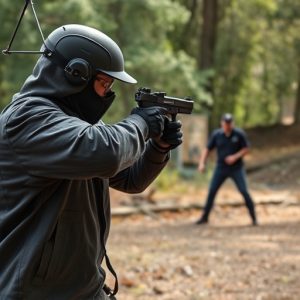Stun Gun Effectiveness: Muscle Incapitation Duration & Self-Defense Guns
The best-rated stun guns for self-defense disrupt the nervous system, temporarily incapacitating att…….
The best-rated stun guns for self-defense disrupt the nervous system, temporarily incapacitating attackers through high voltage and low amperage. The duration of this incapacitation, ranging from 2 to 15 seconds, depends on factors like device power, probe placement, target size and body type. High-quality models maximize disruption while minimizing injury risk with advanced features like long pulse widths and ergonomic designs. Legal considerations and safety features, such as automatic shut-off mechanisms, are crucial when selecting these powerful self-defense tools.
“Stun guns, a popular choice for self-defense, deliver electric shocks that can incapacitate muscle function temporarily. Understanding the duration of this muscle paralysis is crucial, as it impacts their effectiveness in real-world scenarios. This article delves into the science behind muscle incapacitation, exploring various factors influencing stun gun efficiency and duration. We review best-rated stun guns for self-defense, analyzing their features and impact on muscle disability. Additionally, we discuss legal considerations and offer guidance on choosing the right device for optimal protection.”
- Understanding Muscle Incapitation: What Happens When You're Stunned?
- Factors Affecting Duration of Muscle Paralysis from Stun Guns
- Best-Rated Stun Guns: Features and Effects on Muscle Disabilitation
- Self-Defense Scenarios: Effective Use and Time Frames of Stun Guns
- Legal Considerations: Stun Gun Usage and Duration of Muscle Incapitation
- Choosing the Right Stun Gun: Factors for Optimum Muscle Paralysis Duration
Understanding Muscle Incapitation: What Happens When You're Stunned?

When someone is stunned by a stun gun, the device delivers an electric shock that disrupts the nervous system’s normal functioning. This interference specifically targets muscles, causing them to become temporarily incapacitated. The duration of this muscle incapacitation is a key consideration when choosing best-rated stun guns for self-defense, as it directly impacts how long an individual remains defenseless against potential threats.
During a stun, high voltage and low amperage are delivered through the stun gun’s probes into the target’s body. This shock overloads motor neurons, leading to muscle contractions and relaxation, which can result in temporary paralysis. The effects usually last from a few seconds to a minute, depending on factors such as the device’s power output, probe size, and contact point on the body. Understanding these dynamics is crucial for individuals seeking self-defense options, enabling them to make informed choices among various stun guns available in the market.
Factors Affecting Duration of Muscle Paralysis from Stun Guns
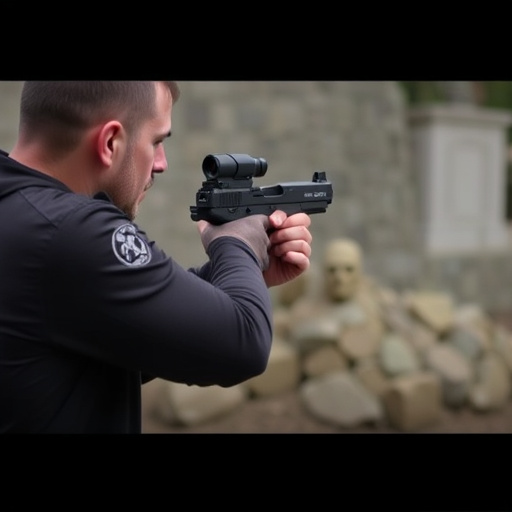
The duration of muscle incapacitation caused by stun guns can vary significantly based on several factors. One of the primary influences is the power and voltage output of the device, with higher-rated stun guns typically delivering more intense jolts that can prolong the paralysis. The best-rated stun guns for self-defense often boast higher ampere levels, ensuring a longer period of muscle disruption.
Additionally, the placement of the stun gun’s probes on the target plays a crucial role. Striking vital nerve centers or muscle groups can result in extended paralysis. The size and body type of the individual being stunned can also impact the duration, as larger individuals may require higher voltage to achieve the same level of muscle incapacitation as smaller ones. Other factors include environmental conditions, such as temperature and moisture, which can influence the device’s performance and the target’s ability to recover quickly.
Best-Rated Stun Guns: Features and Effects on Muscle Disabilitation

When it comes to best-rated stun guns for self-defense, understanding their impact on muscle incapacitation is key. High-quality stun guns are designed to disrupt an attacker’s mobility and combat their defensive abilities through targeted electrical impulses. These devices work by delivering a powerful electric shock that overloads the nervous system, temporarily paralyzing muscles in the affected areas, such as the legs or arms. This muscle incapacitation can enable victims to escape potentially dangerous situations.
The most effective best-rated stun guns often feature advanced features like long pulse widths and high voltage outputs. These characteristics ensure the shock is both intense enough to disable and widely dispersed across the body, minimizing the risk of injury while maximizing the disruption. Additionally, ergonomic designs and compact sizes make these stun guns easy to carry and use in emergency situations, providing individuals with an extra layer of personal safety.
Self-Defense Scenarios: Effective Use and Time Frames of Stun Guns
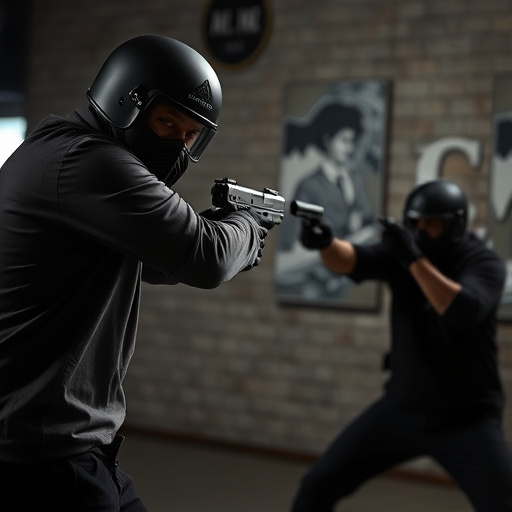
In self-defense scenarios, stun guns have emerged as a popular and effective tool for individuals seeking to incapacitate an assailant temporarily. When it comes to the best-rated stun guns for self-defense, understanding their duration of muscle incapacitation is key. These devices work by delivering a powerful electric shock that disrupts the neuromuscular system, leading to temporary paralysis or loss of balance in the target. The time frame during which a person is incapacitated can vary based on factors like the stun gun’s power output, the location and intensity of the shock, as well as the individual’s physical condition and tolerance to pain.
Generally, stun guns can render a person temporarily helpless for several seconds, ranging from 3 to 15 seconds per single discharge. High-quality, best-rated stun guns often offer longer durations of muscle incapacitation, especially when used correctly. This window of opportunity allows the user to escape or summon help effectively. It’s important to note that continuous use or multiple shocks might extend the period of incapacity even further, ensuring the safety and secure removal of a potential threat from the scene.
Legal Considerations: Stun Gun Usage and Duration of Muscle Incapitation
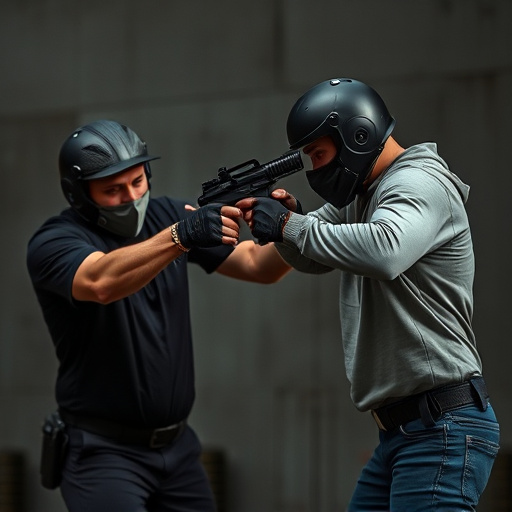
The duration of muscle incapacitation caused by a stun gun is a critical factor in its effectiveness as a self-defense tool, especially with legal implications at play. In many jurisdictions, stun guns are categorized under less-lethal or non-lethal force options for law enforcement and civilian use. However, the specific laws vary widely across countries and states, dictating who can carry and use them, and for how long.
When considering the best-rated stun guns for self-defense, users must understand that these devices are designed to temporarily disable an assailant, providing a momentary escape or time to summon help. The length of this incapacitation typically ranges from 2 to 5 seconds, depending on various factors like the device’s power output and the target’s tolerance or sensitivity. This duration is often enough for self-defense purposes, but it’s crucial to consult local regulations to ensure responsible and legal usage.
Choosing the Right Stun Gun: Factors for Optimum Muscle Paralysis Duration
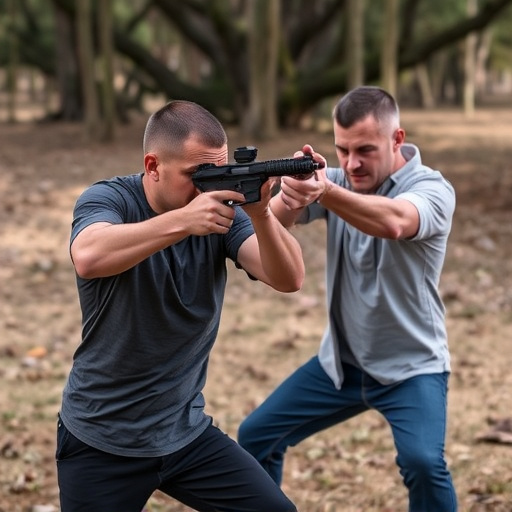
When considering a stun gun for self-defense, understanding its muscle incapacitation duration is crucial. This factor determines how long an attacker will be temporarily disabled, providing valuable time to escape or seek help. The best-rated stun guns for self-defense often prioritize high voltage and low amperage output, as this combination ensures maximum disruption of muscular control without causing serious harm. Amperage levels below 150mA are generally recommended for optimal muscle paralysis duration while minimizing the risk of long-term injury.
Choosing a stun gun also involves considering factors like weight, size, power source (rechargeable vs non-rechargeable), and range. A balanced approach ensures that you have a device that is both effective and manageable in an emergency situation. Additionally, looking for models with safety features, such as automatic shut-off mechanisms after continuous use or motion sensors, can enhance safety and reliability. These attributes collectively contribute to ensuring the longest possible duration of muscle incapacitation when needed most.
In conclusion, understanding the duration of muscle incapacitation from stun guns is crucial for effective self-defense. Factors like voltage, pulse width, and delivery method significantly influence the time frame of paralysis. While legal considerations vary by region, knowing how long a stun gun’s effects last can help individuals make informed choices when selecting the best-rated stun guns for their protection needs. For optimal muscle paralysis duration, consider features that enhance the weapon’s effectiveness without compromising safety.

